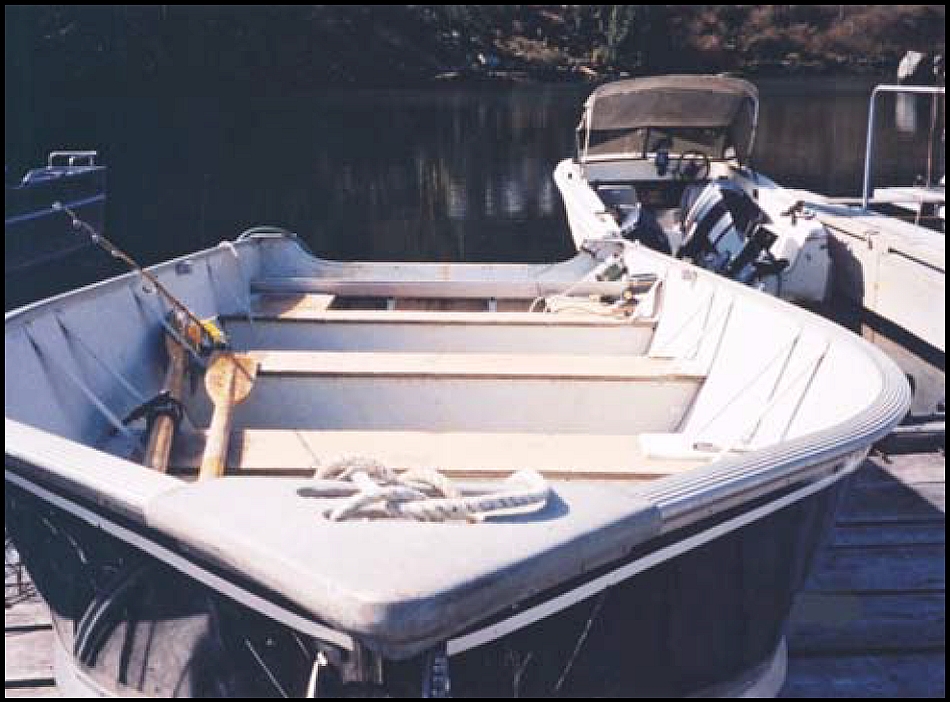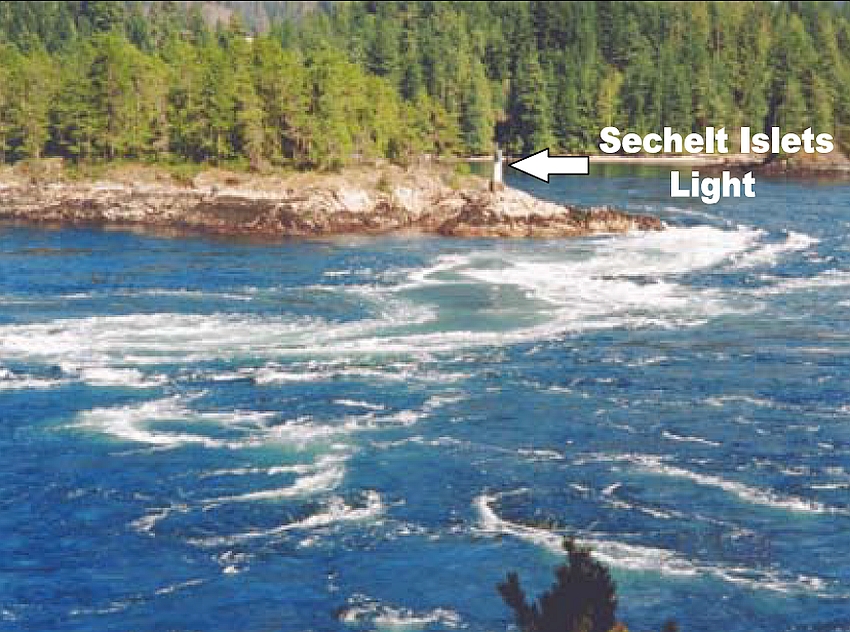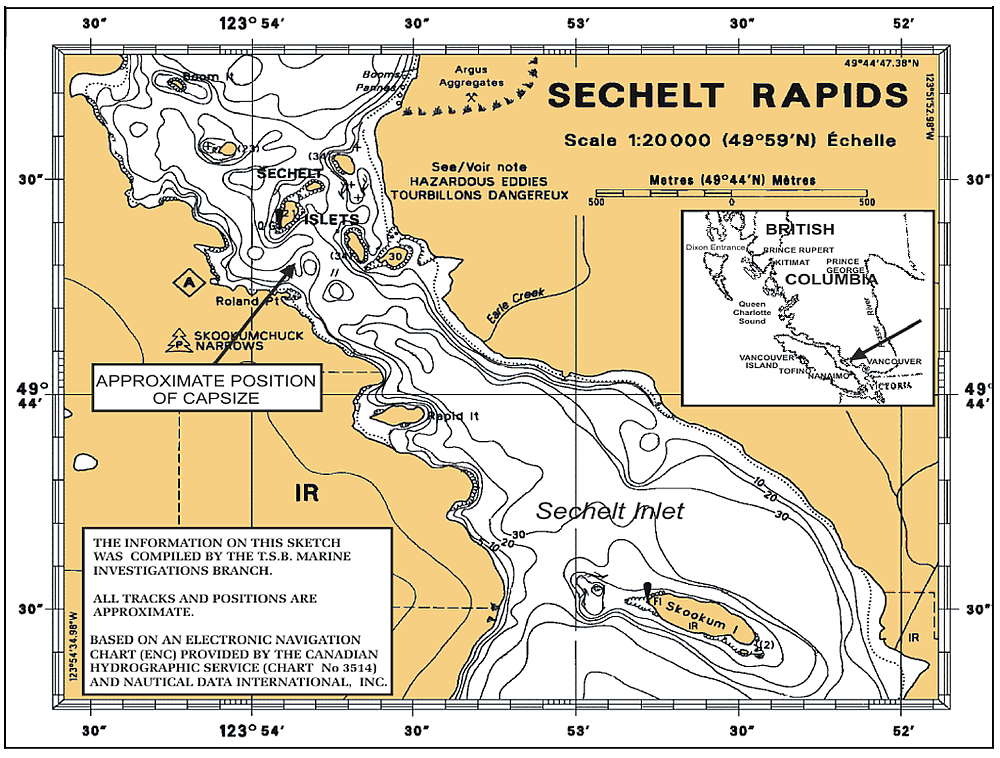Capsizing and Loss of Life
Small open boat Deep Water
Sechelt Rapids near Egmont, British Columbia
The Transportation Safety Board of Canada (TSB) investigated this occurrence for the purpose of advancing transportation safety. It is not the function of the Board to assign fault or determine civil or criminal liability. This report is not created for use in the context of legal, disciplinary or other proceedings. See Ownership and use of content. Masculine pronouns and position titles may be used to signify all genders to comply with the Canadian Transportation Accident Investigation and Safety Board Act (S.C. 1989, c. 3).
Summary
In the early afternoon of 01 April 2002, the rented open boat Deep Water had five persons on board when it capsized in the turbulent waters of Sechelt Rapids near Egmont, B.C. Four persons were rescued and the other drowned.
Factual information
Particulars of the vessel
| Name | Deep Water |
|---|---|
| Hull Identification Number | POXN8945 |
| Type | Open aluminum sport boat |
| Gross tonsFootnote 1 | +/- 1 |
| Length | 4.9 m |
| Breadth | 1.9 m |
| Draft | 0.5 m at bow |
| Built | 1955 - Indiana U.S.A. |
| Propulsion | One 20 hp Yamaha outboard gasoline engine |
| Owner | Private owner |
Description of the vessel
The Deep Water is a small, open sport fishing boat of rivetted aluminum construction. The vessel's hull is a conventional V-form design with a transom stern, four athwartships seats and two longitudinal bench seats aft. Positive flotation is provided by Styrofoam blocks installed beneath three of the athwartships seats. A Canadian Coast Guard plaque attached to the vessel's interior transom indicates that the vessel meets Canadian government Construction Standards for Small Vessels. The vessel was fitted with a 20 horsepower outboard engine of recent manufacture.
Safety equipment on board the vessel included the following: five government-approved personal flotation devices (PFDs), a whistle, one 10 m buoyant heaving line, and a medical emergency kit with bandages and disinfectant.
History of the voyage
In the mid-morning of 01 April 2002, a group of five friends prepared to rent a small aluminum sport fishing boat from a marina in Egmont, B.C. Only one of the friends spoke English well enough to arrange the rental of the open boat Deep Water. The owner told the English-speaking renter to stay clear of the turbulent waters of Sechelt Rapids.
The Deep Water left Egmont at about 1000 Pacific standard timeFootnote 2 and proceeded north to the Agamemnon Channel. After nearly an hour of poor fishing, the boat made its way southward through Sechelt Rapids into Sechelt Inlet. The group fished there until about 1245, when they attempted a return voyage northwards through Sechelt Rapids. Unlike their first transit through the Rapids, there was now a strong northerly ebb current. The Deep Water was caught in a strong backeddy,Footnote 3 which turned the boat through 180 degrees and sent it back in a southerly direction towards Sechelt Inlet. Before the boat could return to the relatively calm waters of the inlet, it capsized in a section of the rapids between Sechelt Islets and Roland Point.
The boat capsized to starboard while in the turbulent waters of a backeddy. Of the five persons aboard the boat, all but one were wearing PFDs. Two persons clung to the boat's overturned hull and were rescued later. Two swam to shore near Roland Point. All four survivors were taken to St. Mary's Hospital in nearby Sechelt, B.C., where they were treated for mild hypothermia. The fifth person had no PFD and was last observed clinging to an empty plastic cooler while being swept away by the fast flowing water. His body was recovered two months later in Sechelt Inlet. (See Appendix A - Sketch of occurrence area.)
Geographical information
Sechelt Rapids, locally known as Skookumchuck Rapids, is located at the entrance of Sechelt Inlet. The rapids extend over an area approximately 1000 m long and 500 m wide, between Roland Point and the Sechelt Islets. Tidal streams within the rapids can reach 16 knots during large tides.
The strongest ebb stream occurs just west of Sechelt Islets light, with a strong cross-channel set toward the WNW. A large backeddy occurs to the north of the light, and whirlpools form close to the light.
It is hazardous for any vessel to attempt to navigate Sechelt Rapids except at or near slack water.Footnote 4
Weather and current information
The Canadian Hydrographic Service Tide and Current Tables, Volume 5, predicted that a 13 knot maximum ebb current flowing in a 315° True direction would occur at 1305 hours, which is the approximate time of the accident. There was no recorded wind and the skies were clear and sunny.
Local boat rental businesses
Egmont, B.C., is the northern-most settlement at the end of 86 km of roadway along the Sechelt Peninsula, which has its southern-most terminus at Langdale, B.C. Commonly known as the "Sunshine Coast," Sechelt Peninsula is characterized by numerous sheltered bays and waterways, which are popular destinations for tourists wishing to rent small open boats such as the Deep Water for either fishing or sightseeing excursions.
Operator experience and certification
Even though the person in the group designated as the operator had rented a boat from the same company on two previous occasions, he was not an experienced boat handler. Neither he nor any of the other occupants had received any marine training or certification, nor were they required to have done so.
Boat rental safety
The federal Office of Boating Safety (OBS)Footnote 5 is responsible for promoting safe and responsible recreational boating activities. The areas of the OBS responsibility include the administration of the Competency of Operators of Pleasure Craft Regulations and those sections of the Small Vessel Regulations that apply to pleasure craft.
In the case of operating a pleasure craft rental, one of the following proofs of competency are recognized:
- Pleasure Craft Operator Card,
- written proof of having completed training prior to 01 April 1999, or
- a Rental Boat Safety ChecklistFootnote 6 completed and signed by both the person who makes the pleasure craft available for rent and the person who will operate it.
These proofs of competency requirements are being phased in over a ten-year period and will come into full force on 15 September 2009. However, in the interim as in this instance, the renter, who was born before 01 April 1983 and who was renting a motor boat over four metres in length, was not required to complete and sign a Rental Boat Safety Checklist or to have any other recognized proof of competency.Footnote 7
The intent of the Rental Boat Safety Checklist is to improve the safety of rental motor boat operations by promoting the safe use of navigable waters, developing a safety attitude towards pleasure boating, and providing a means for pleasure craft operators to demonstrate their competency. The checklist contains the tasks, skills and knowledge necessary for safely operating a rental boat.
Search and rescue operations
Rescue operations were initiated by an emergency 911 phone call made by a person ashore who observed the accident. During the afternoon and evening of the accident, the Joint Rescue Co-ordination Centre in Victoria, B.C., tasked 11 vessels and one Search and Rescue helicopter to engage in the search and rescue operations. In addition, provincial Emergency Health Services dispatched one helicopter and two ambulances. One of the ambulances was used to transport the survivors to St. Mary's Hospital in Sechelt, B.C.
Analysis
Operator boat handling experience
When transiting an area of rough water, a vessel's safety, to a large extent, depends on the boat-handling skills of its operator. In this instance, none of the persons on board the rental boat had received any formal operator training. Although the operator at the time of accident had some boating experience - he had previously rented boats - he was not an experienced boat handler. Hence, he may not have recognized the dangers associated with operating a small open boat in fast flowing tidal streams.
It is hazardous for any small open boat to attempt to navigate swift flowing or turbulent waters. The attempt to navigate Sechelt Rapids when the ebb current was at or near its maximum rate of flow contributed to the boat coming under the influence of a strong backeddy and subsequently losing transverse stability and capsizing.
Use of lifejackets and personal flotation devices
Pleasure craft are required to be equipped with a Canadian-approved lifejacket or PFD of an appropriate size for each person on board. The lifejacket, developed for professional mariners, was designed to provide buoyancy and, in the case of injury, keep an unconscious wearer's head face-up above the surface. The PFD, on the other hand, was developed for pleasure craft operators. The premise behind the development of the inherently buoyant PFD was that, while it offers reduced performance as compared to a lifejacket, in that it will not keep a wearer's face clear of the water, it will keep users afloat and is more likely to be worn than the higher performance, but less comfortable, lifejacket.
Although it is not mandatory for persons to wear their lifejacket or PFD at all times when on board a vessel, a Canadian Red Cross Drowning Report shows that more than 70 percent of people who drown while boating are not wearing a PFD. In this instance, the one person who was not wearing a PFD - the operator of the boat - drowned.
In 2002, the Canadian Safe Boating Council (CSBC) struck a Lifejacket/Personal Flotation Device (PFD) Taskforce to examine the issue of mandatory PFD wear legislation for recreational boaters in small craft. The Taskforce was in progress at the time of the occurrence. A background research paperFootnote 8 summarizes the best available evidence pertaining to mandatory lifejacket/PFD use. It was recommended that the PFD Taskforce and the CSBC as a whole work toward mandatory PFD wear legislation.
Assessing operator competency
Operator knowledge and operating skills are of critical importance to the safety of persons on board any vessel. However, some of the boat-renting/chartering public do not have the necessary proficiency to operate a small boat.
In this instance, the owner of the rental company gave verbal operating instructions for the outboard motor to the group's representative and told him to stay clear of Sechelt Rapids. The operator of the rental boat had previously rented boats from the same company.
Recreational boating safety requires the cooperative efforts of regulators, rental businesses and renters themselves. However, in this instance, none of the people on board the pleasure craft had received any safety training; none possessed a Pleasure Craft Operator Card and none was required to do so.
The rental agency representative did not provide the renters with a written Rental Boat Safety Checklist or any other written documentation concerning the safe operation of the boat or dangers present in the intended geographical area of operation; he was not required to do so.
The representative did provide a verbal warning of the dangers associated with Sechelt Rapids, but the effectiveness of the warning is considered to have been diminished by the limited English language skills of the renters.
A review of seven established boat rental companies located on the Sechelt Peninsula showed that the companies employed a wide range of procedures in assessing the boating skills of boat renters. One company required a prospective renter to complete a printed checklist identifying boating experience, outboard engine operating experience, and a signed acknowledgment that the rental company representative had informed the renter on the safe operation of the boat to be rented (including its safe starting) and the use of on-board safety equipment.
Other companies required a renter's signature on written documents setting out the rental agency's limit of legal liability but provided the boat renter with no written information related to boating safety or required operator experience. Such practices do not protect the physical safety of boat renters.
Currently, regulations do not require all persons wishing to rent a boat over four metres in length to have training.
Language communication difficulties
A large number of the seven Sechelt Peninsula boat rental companies' clients spoke limited English and most of those clients spoke either Mandarin or Cantonese. Language difficulties compromise the safety of vessels, as they hamper communication between personnel, be they ashore or afloat.
Communication of safety-related information becomes less effective when there are language barriers. It is, therefore, imperative that safety information to the renters be communicated/presented in a format such that, despite language barriers, the renters will be able to reasonably understand the safety message. In this instance, because the operator of the rental boat entered the Sechelt Rapids area, he may not have fully understood the warning to stay clear of them.
Findings
Findings as to causes and contributing factors
- The operator was not an experienced boat handler, had difficulty with the English language, and he may not have fully recognized the dangers associated with operating a small open boat in fast flowing tidal streams.
- The attempt to navigate Sechelt Rapids when the ebb current was at or near its maximum rate of flow contributed to the boat coming under the influence of a strong backeddy and subsequently losing transverse stability and capsizing.
- The one person who was not wearing a PFD drowned.
- The Competency of Operators of Pleasure Craft Regulations permitted rental of the Deep Water without proof of competency.
Findings as to risk
- The rental company's reliance on a verbal warning about dangers associated with the Sechelt Rapids increased the risk of the boat becoming involved in an unsafe situation.
- The current method of delivering safety information to boaters who have limited knowledge of the English language increases the risk of poor communication and will continue to place these boaters at undue risk.
Safety action
Safety concern
Assessing operator competency for rental pleasure vessels
In response to concerns from the rental boat and outfitter industry for an alternate means of demonstrating proof of competency, other than having a Pleasure Craft Operator Card, operators of power-driven rental pleasure boats may complete and sign a Rental Boat Safety Checklist. However, given that these proficiency requirements of the Competency of Operators of Pleasure Craft Regulations are being phased in over a 10-year period, only by 15 September 2009 will all operators of rental boats be required to demonstrate proof of competency.
A Rental Boat Safety Checklist Standard, the purpose of which is to facilitate the development of checklists by the industry for their customers, was developed in consultation with the rental boat and outfitter industry. The Standard was promulgated for use in 1999. The Standard lists the minimum elements of boating safety knowledge, including knowledge of local hazards and conditions, for any checklist. Although there are rental companies that currently make use of a safety checklist, it is the Transportation Safety Board's (TSB's) understanding that there may be other companies that do not. As demonstrated in this investigation, current methods of delivering safety information may not be sufficient to assess boating skills and impart the knowledge necessary to safely operate a rental boat.
The regulations apply to a wide range of recreational pleasure craft operators and include private and commercial operations. There are few fatalities involving pleasure boat rentals reported to the TSB (13 since 1995), however, the number of unreported non-fatal occurrences involving such vessels is likely to be much higher. The Red Cross, for example, reports an average of nearly 200 pleasure boating-related fatalities and estimates approximately 6,000 unreported non-fatal accidents every year. The Board, therefore, is concerned that until such time that all persons are required to demonstrate proof of competency (i.e., end of summer 2009), some persons operating rental boats may place themselves and others at risk. The Board will monitor this concern in future investigations.
This report concludes the Transportation Safety Board's investigation into this occurrence. Consequently, the Board authorized the release of this report on .



